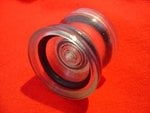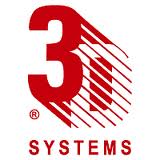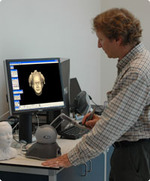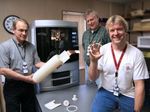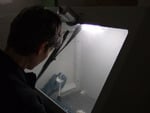“Have you ever made a Yoyo with a 3D printer”, asks bollweevil in this Yoyonation forum discussion. Yoyo enthusiasts know their yoyos, and many custom build them. Now, they consider using a 3D printer to do so. The result is interesting, as YoMattSta replies: “Yes, I have. I made 2 yoyos on a 3d… Continue reading 3D Yoyo
usage
Tactile Images
Valerie Belmonte, a photographer, bumped into a book containing tactile images – that is to say, images with raised relief. Tactile images can be used by visually impaired folks to gain an understanding of visual material that would otherwise be difficult to do. Valerie posts a list of links to research on tactile images and… Continue reading Tactile Images
Blind Man Sees!
An incredible story comes from 3D Systems, a 3D service bureau that we’ll have to review very soon. The University of Louisville’s Rapid Prototyping Center and Harvest Technologies (a 3D Systems provider) together helped produce an amazing result for the popular TV show “Extreme Makeover: Home Edition”. The show’s premise is to rapidly rebuild or… Continue reading Blind Man Sees!
3D CSI?
We’ve all seen those amazing police sketch artists who transform vague witness accounts into highly realistic portraits, often featured in “WANTED” posters. More recently artists have used manual techniques to create lifelike head and face models by applying clay “muscles” and “skin” to casts of skulls. Today we see the same function accomplished with 3D… Continue reading 3D CSI?
A Different Kind of Prototyping
Gene Anzalone uses 3D printing in a slightly different way than we’ve seen before. He prints 3D objects as other engineers might. But then things are a little different. He uses the objects directly in design meetings rather than taking traditional 2D diagrams. The 3D objects instantly convey much more information about the item under… Continue reading A Different Kind of Prototyping
Generator X 2.0 Revisited
Remember back to early December? We posted about the GeneratorX 2.0 workshop, an exhibition of designer works who used various digital fabrication techniques to produce amazing items. ArtDaily reports on a presentation entitled “Beyond the Screen”, where participants from the GeneratorX 2.0 workshop will show their works. As we’ve suggested many times before: there are… Continue reading Generator X 2.0 Revisited
Psychological Experiment Uses Fabbing
3D printing is being used to manufacture custom objects for psychological experiments. The shapes are of typical objects, but they are not robust enough for normal use, since most 3D printers today cannot produce objects of sufficient strength. However, the psychological experiment involves subjects merely touching the objects to identify them by shape. This use… Continue reading Psychological Experiment Uses Fabbing

